Korean chrysanthemum: types and recommendations for growing

Korean chrysanthemum is an artificially bred hybrid of garden chrysanthemum. Its leaves are similar to oak leaves, so these varieties are also called "oaks".
The perennial is highly resistant to frost and is well cultivated in the open field in the weather conditions of our country. The Korean beauty is a favorite element of landscape designers, ideal for compositions in need of ground cover addition, and an excellent decoration for rock gardens, borders, flower beds and rabat beds. In open areas, it is customary to plant plants with small flowering, and large-flowered varieties are more suitable for cutting.
Description
Korean chrysanthemum looks like a compact or spreading bush with straight stems and dull gray-green smooth or pubescent leaves with a specific odor. The color of the buds is bright and varied. The cold resistance of oak trees allows them not to be afraid of the first snow. They differ in flowering time, height, type and a variety of color palette.

By height, the bushes are:
- undersized (curb) - up to 30 cm, often grown in pots;
- medium-sized - up to 50 cm, very effective in cut;
- tall - up to 1 m.

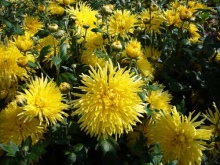

Also flowers are small-colored and large-colored. Chrysanthemums have flat, simple non-double, double and semi-double, pompom, spherical, hemispherical, curly, radial, anemone inflorescences.

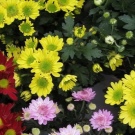



Early varieties begin to bloom in mid-summer, but are not winter-hardy and require additional care at the first frost. Large inflorescences are more susceptible to the negative effects of frost, especially varieties with white flowers.
The most frost-resistant are low-growing double varieties with golden-yellow and orange-yellow inflorescences, keeping the freshness of the buds until the first snow.
Varieties and varieties
As a result of the work of breeders from different countries, there is now a huge number of perennial winter-hardy varieties of this decorative culture.
From undersized varieties will attract attention:
- "Super Bronze" with fiery bronze double inflorescences;
- "Minx" - a lush curb bush with raspberry inflorescences and peak flowering in September;
- "Krasunya" - a beige-red original September variety that tolerates drought well.
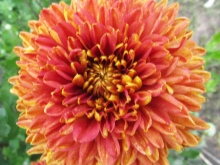


There are curb varieties 20 cm high and for the second level in a 40 cm flower garden.
Among the medium-sized varieties, suitable for both elegant bouquets and for planting in open soil, the following are in demand:
- "Surprise" - autumn-flowering variety with terry terracotta inflorescences;
- "Lelia" - a late-flowering variety of a columnar shape with abundant flat small inflorescences of a violet-pink hue. Blooms until frost.
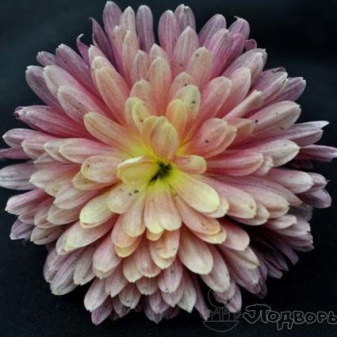
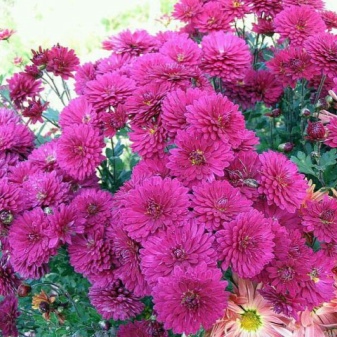
Among tall frost-resistant perennials wintering in open soil, the following stand out noticeably.
- "Umka" - with white pompom-shaped terry inflorescences with a pinkish tinge. The middle of the flowers is creamy. Used for cutting and landscaping. It blooms twice per season.
- "Apple Blossom". Large-flowered type of white, pink, burgundy and cream flowers with a subtle scent. It is used for cutting. Blooms until October.
- "Sonatina" - a variety with bright pink double inflorescences with a slight silvery tint and emerald green smooth foliage. Blooms in late autumn.
- "Cream Jewel". In early July, the color is almost white with the most delicate creamy pink shades, and in August - apricot tone.
- "Smile of Autumn" - late flowering plant with inflorescences from light to dark orange tone.
- Emmy - a variety with bright and large inflorescences of cream and brown color, blooms in early autumn.
- Enona - variety with creamy and yellow flowers and long flowering in summer and autumn seasons.





Solid plantings that create the effect of a flower carpet, grown from a mixture of seeds, look especially impressive. For example, a mixture of "Stars of the Galaxy" is in demand - medium-sized cold-resistant perennials with a variety of bright double inflorescences, baskets of medium and large size... The mixture is suitable for planting in containers or outdoor pots. You can transplant crops in a flowering state. The mixture has several shades. The most common tones are yellow, bright red and pale pink.

These varieties have proven themselves excellently in Russian regions.
Combination with other colors
It is not difficult to create a composition from a wide variety of chrysanthemums, they are well compatible with each other. But these flowers will look more advantageous with a variety of ornamental plants. Korean chrysanthemums dominate flower ensembles, so it is important to know the rules for the harmonious combination of various plants in group plantings.
The combination of lush chrysanthemums and astrometry with original and bright petal gerberas looks great. The joint autumn planting of chrysanthemums and asters is expressive. Intersperses of tall ornamental grains are perfect: fescue, evergreen oats, silver wormwood.


A flower garden with planted chrysanthemums will perfectly set off the planting of low-growing coniferous shrubs, for example, juniper and boxwood. The bright rounded shapes of chrysanthemums will smooth out and give liveliness to strict evergreen crops. A Korean blend with a stunning variety of colors goes well with them. White and lilac inflorescences of chrysanthemums, planted next to a juniper, favorably set off the delicate silvery needles. But when planting, they need to allocate a lot of space for full growth.

Low-growing border chrysanthemums will become a festive frame and decorative addition to planted perennial lupins, Pushkinia, cannes, daffodils, or annuals - geraniums, carnations, marigolds, phlox, levkoi, which serve as the main background.

The "Lelia" variety is ideally combined with green-leaved and red-leaved shrubs. Burgundy foliage is also a great backdrop for chrysanthemum varieties with contrasting inflorescences.
You can create a composition on the site based on different types of harmonious combinations. Today, a monochrome garden is a fashionable design solution. Monochromatic compositions look impressive and restrained at the same time. A single color scheme uses only one base color and many of its shades. As an example, red chrysanthemums "Aurora" and salvias "Rosebud" with delicate pink flowers. The composition of a flower garden of the Bayram variety with blue-violet inflorescences and blue delphinium or clematis flowers looks very elegant.



With a contrasting planting pattern, completely opposite colors of ornamental plants are combined. It is a good idea to leave one color clear and the other slightly damp, as two strong colors look sharp together. If you reduce the intensity of one color, then in this form the combination looks more natural and eye-catching. For example, blue irises and carnations harmoniously coexist with the Super Bronze variety of chrysanthemums with yellow and bronze colors.

If we take into account the flowering time of neighboring plants, then you can get a long-flowering composition on the lawn that will delight the eye until the first snow.
Landing
To properly plant Korean chrysanthemums, you need to choose a suitable site.Agricultural technicians do not recommend setting aside a place for oaks where vegetables were previously grown. It is better to plant them where ornamental grasses and annuals grew before.
Heat-loving perennials will bloom better in calm and sunny places. The specimens growing in partial shade are weaker, they have reduced cold resistance and insufficiently bright inflorescences. And they will begin to bloom much later.
The landing site should be located at a low elevation, where there is no stagnant rainwater. In the swampy lowlands, the flowers will rot. Drainage should be arranged on such soil.
It is advisable to grow low-growing bushes on a slope.
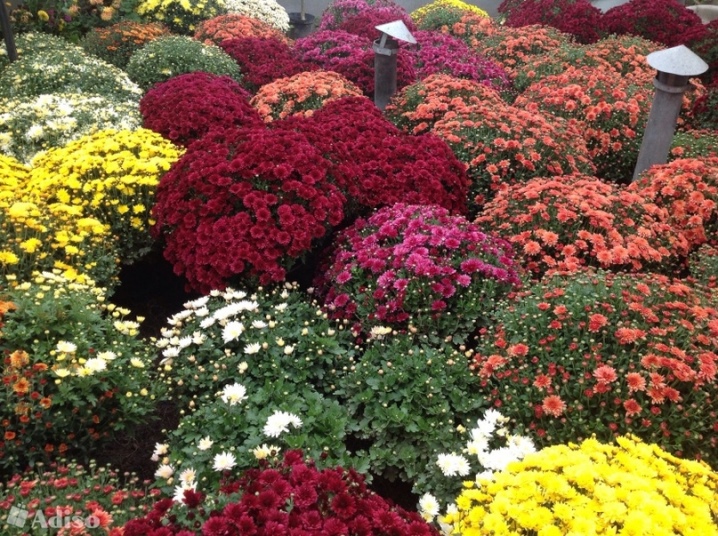
The soil is preferable with a loose structure, moisture permeable. Light loams are most suitable. Sandy dry and dense clay soils are unsuitable. Preparation of the soil for planting begins in the fall with the introduction of manure and superphosphate. It is recommended to mulch the soil with chopped pine bark, needles or oat straw. Slightly acidic soils are most suitable for this. If necessary, the acidity of the soil is corrected by liming with a solution of slaked lime, chalk or dolomite flour.



Planting begins in late spring, when the danger of the return of spring frosts has passed. Seeds are placed not in holes, but in rows with a distance of up to half a meter between them. This will facilitate further care of the seedlings. Before planting, the cuttings are moistened with a growth stimulator for better rooting.
After planting, the soil is sufficiently moistened, the whole season is regularly loosened and cleaned from weeds. Every 3 years "Korean" women need to be transplanted to a new place.
If you grow a perennial in a permanent place for up to 5 years, then it should be periodically thinned out. This will prevent the buds from crumbling and unsightly.

Care
The subsequent care of the oak trees is not difficult. During the season, it is recommended to carry out at least three dressings with solutions of nitrogen, and during the formation of buds - potassium fertilizers. It is better to conduct them with watering at dawn and in the evening, after sunset.

The water should be soft, rain or settled. With a lack of it, the plants become rough and lose their attractiveness. After watering, the soil needs frequent loosening, which destroys the integrity of the crust on its surface and improves water and air permeability. Then the roots and shoots begin to grow more intensively and form a bush. Loosening destroys weeds and pests wintering in the ground.


It is very useful to mulch chrysanthemums with pine needles, chopped pine bark or oat straw, which will prevent soil pathogens from getting on perennials during watering and rains.
Before the buds begin to swell, it is advisable to treat the bushes with a growth stimulant. Then more inflorescences with fast and friendly flowering will be tied on the chrysanthemum. The formation of greater splendor consists in the removal of early inflorescences and in the shortening of the shoots of the plant. At the stage of appearance of 7-8 leaves, pinching is carried out. Regular removal of dead buds will significantly extend the flowering time.

The bush can withstand frosts down to -7 ° C. With the onset of constant soil frosts, flower growers begin to prepare the crop for winter. They carry out all the necessary agrotechnical measures. It depends on how much the flower will further please with the growth and abundance of inflorescences.
The first necessary procedure is pruning. In a frost-resistant variety, the bushes are cut off, leaving only 10 cm, all the garbage is removed from the site, and for preventive purposes, the plants are sanitized from old leaves, followed by processing them with special means.

Further, under each bush, a complex potassium-phosphorus fertilizing is applied. These elements will help the root system to increase resistance to freezing. With the arrival of cold weather, the plants are covered until spring - first with a layer of mulch, spruce branches, shavings, sawdust are placed on top. Non-frost-resistant varieties are also pruned to make it easier to store, they are transplanted into boxes along with an earthen lump. Such flowers hibernate in basements.

Reproduction
Korean beauties are propagated in two ways: by seeds and vegetatively. but the method of growing from seeds is more often used by breeders... In our weather conditions, seeds ripen only in some early varieties, and seedlings grown from seeds do not repeat the varietal parental qualities. Therefore, it is advisable to use vegetative methods: dividing the rhizome or bush and grafting.
The period for dividing a bush or rhizome is calculated so that the chrysanthemum has time to take root before winter. The plant is dug up and the root system is divided into parts with pruning shears, each of which should contain up to 3 shoots, planted in holes with humus and watered abundantly. Almost all delenki take root. Flowering occurs in the year of transplantation.

Cutting is more often used. First, the best uterine specimens are selected. For spring cuttings, they are dug up in the fall and moved indoors. Cuttings up to 7 cm in height are harvested in spring from root shoots or side shoots. They are planted in planting containers with nutrient soil, sufficiently moistened and covered with glass or film.
When the cuttings grow up, they are pinched to stimulate the growth of lateral shoots. Such pinching is done several times. They allow you to form a compact and resistant to low temperatures bush with an abundance of lush inflorescences.
All this time young plants and mother plants are regularly fed with solutions of organic matter and mineral complexes... Strengthening the cuttings is facilitated by a two-week hardening in the open air. The entire rooting process takes approximately 2 months. When warm weather sets in and the return of spring frosts is no longer expected, the rooted cuttings are planted in open ground in a prepared place.
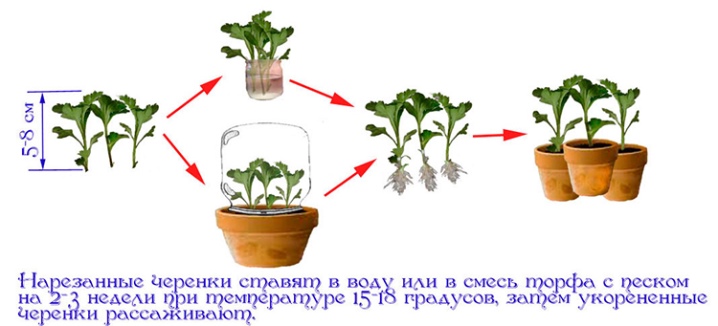
Diseases and pests
Unfavorable weather conditions and insufficient care for oak trees can contribute to their disease.
With a lack potassium-phosphorus fertilizers oak trees get sick with powdery mildew when the lower part of the plant stem is bare and the leaves turn black... It appears both when waterlogged, and when the density of the bush is too high. In addition, a large temperature difference can be the cause. In case of defeat by this disease, it is necessary to treat the plants with preparations containing copper. You can also do preventive spraying in early summer.

The most common diseases are fungal: black and white spot, stem rot, rust fungi, ascochitis, verticillosis, leaf septoria. They are fought with the help of spraying with fungicides.



Viral diseases cause dwarfism, mosaicism, aspermia, rosette, greening of inflorescences, and cannot be treated. Affected plants are dug up and burned.
Of the pests of the Korean chrysanthemum, aphids, spider mites, leafhoppers - slobbering pennits, field bugs and tobacco thrips threaten. To destroy them, insecticides are used.





Slugs eat leaves, and nematodes eat plant roots. Destroy slugs with ulicide or metaldehyde. They fight the nematode with the drug "Dekaris".
Prevention measures against diseases and pests consist in the use of the required amount of potassium and phosphorus fertilizers, in a more rare planting of plants, regular cleaning of the site from fallen leaves, in the fight against weeds, loosening of the soil cover and the root zone of the crop.

Examples in landscape design
A variety of brightly colored inflorescences, frost resistance, long flowering of chrysanthemums - all this attracts flower growers and is often used by them to create decorative landscape designs.
There are rules for joint planting, applying which you can create successful color compositions. without excessive variegation and without monotonous, inexpressive combinations.
Modern trends in color compatibility recommend taking into account the planting density, plant height.
All adjacent plantations should equally respond to illumination, soil composition and irrigation frequency and should not be affected by anything during their life cycle.


When planting, it is necessary to take into account that some plants do not oppress others with their size and active consumption of resources. For example, all representatives of the buttercup family suck water and all nutrients from the earth, thoroughly depleting it, which causes their closest green neighbors to suffer... In addition, the roots of members of these families secrete substances that are harmful to other species. And, conversely, with a well-done planting, plants are able to protect themselves and others from pests and help everyone in development. Marigolds and sage are able to drive away harmful insects.


Continuous flowering lawns can be formed by using varieties of different flowering periods. Then some flowers will continuously replace others.
If you correctly plant chrysanthemums with other varieties of plants, adhering to the recommendations of experts, then you can enjoy the magnificent flowering of these exotic beauties for a long time. Korean chrysanthemums will perfectly take root in a joint area with different types of ornamental plants.
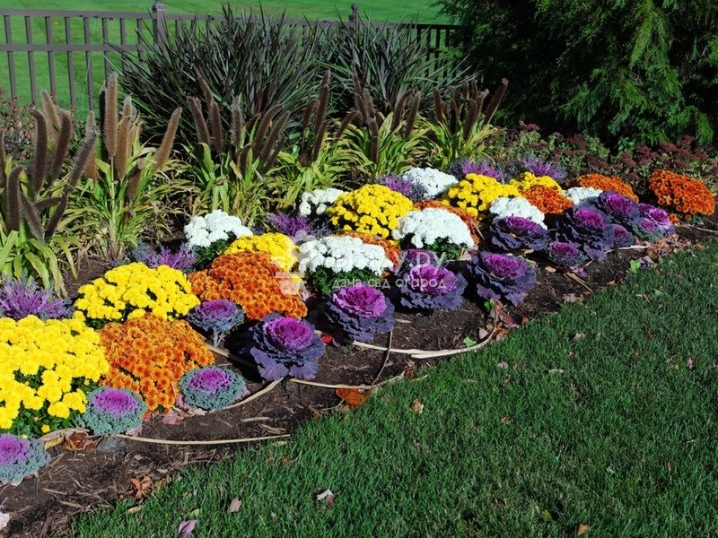
Beds with multi-colored assorted chrysanthemums will make the site a colorful and elegant carpet in the fall.

Single plantings of chrysanthemums are also expressive.

A flower bed of tall and border chrysanthemums.

Having planted chrysanthemums contrasting in color, you can create an interesting composition.

Many annuals will become wonderful neighbors for chrysanthemums.

Chrysanthemums and asters are also a wonderful combination.

See below for more details.







































































































The comment was sent successfully.